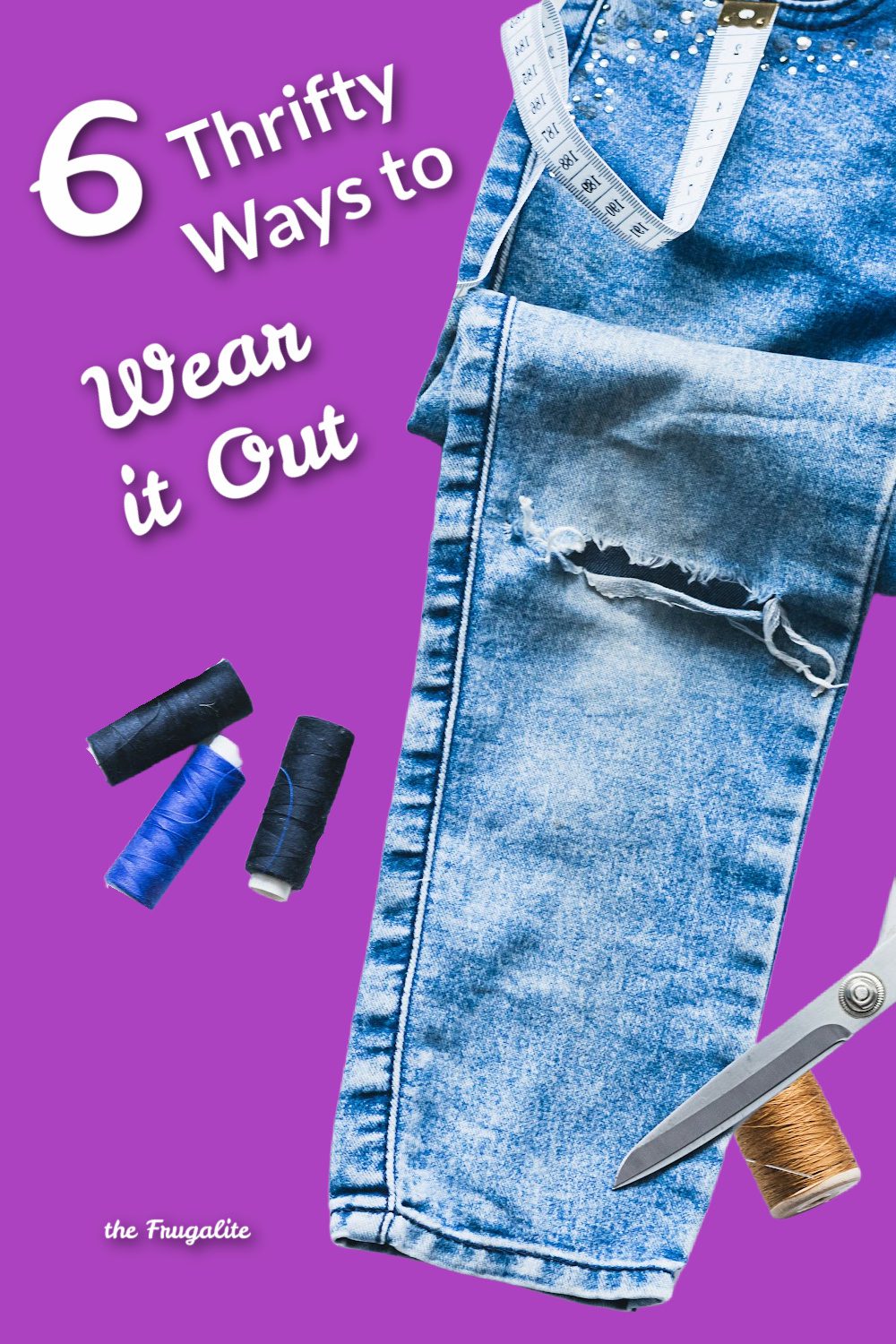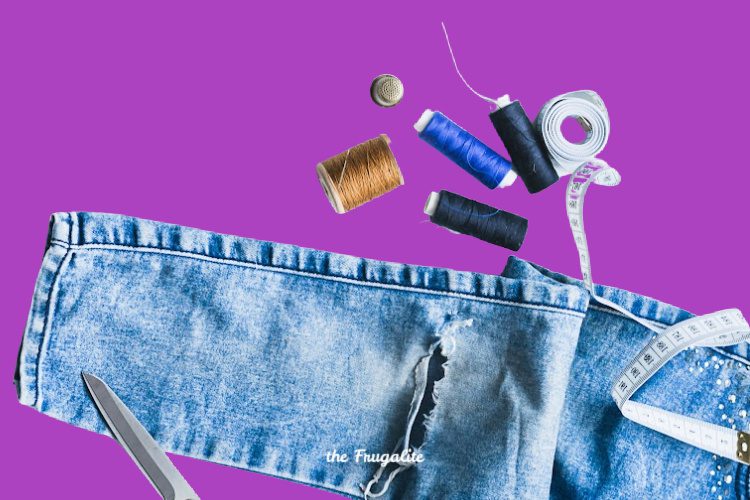(Psst: The FTC wants me to remind you that this website contains affiliate links. That means if you make a purchase from a link you click on, I might receive a small commission. This does not increase the price you’ll pay for that item nor does it decrease the awesomeness of the item. ~ Daisy)
A while back, I started a series on the Great Depression adage, “Use it up, wear it out, make it do, or do without.” We’ve already talked about using it up. Today, let’s talk about ways to wear it out.
Before I began traveling full time and limiting my wardrobe to just what would fit in 2 suitcases, I had never really experienced wearing things out. But using the exact same items on a daily or weekly basis put wear and tear on them that I wasn’t accustomed to seeing. I had been spoiled in the Land of Plenty with weeks’ worth of socks and underwear, half a dozen (or more) pairs of choose from which to select, and the ability to just go into the store and buy more of anything that was beginning to look ragged or threadbare.
This taught me some important frugality lessons about wearing stuff out. I had never before worn sneakers until they had holes in the toes and soles. I had never blown through nearly every sock I owned.
1) Buy better quality
First, whenever you can, purchase items of high quality. As financial difficulties increase and the supply chain continues to unravel at a head-spinning speed, you may find that replacing a low-quality item isn’t as easy as it once was. You, too, will witness the difference between a phone cord from the dollar store and a phone cord from a name brand at an electronics store.
In some cases the initial outlay of more money will prove to be by far the most budget-friendly choice. After all, poking your big toe through a pair of cheap socks the third time you wear them isn’t just as annoying as all get out. It adds up if you have to replace your socks on a monthly basis. While socks and other things can be mended, when you start out with low-quality materials, the repairs do not hold for very long.
If you can afford it, go with better quality options and it will take much longer to wear it out.
2) Maintain it
Whatever quality of time you choose to buy, or whatever you have on hand, the way you maintain it can make a bit difference in how soon you wear it out.
For example, most ladies are well aware that putting a bra in the dryer is a no-no, particularly if it has underwire and shape. Your bras will last far longer if you hang them to dry. The same is true for sweaters or any material that is prone to pill, although many of those items should be laid flat to dry.
It goes further than clothing. Maintaining your vehicle costs extra money at the time but will help to prevent far more expensive repairs and towing bills when it breaks down due to lack of maintenance. Washing off the road or ocean salt can help prevent rust and corrosion on your vehicle.
By cleaning out the gutters on your home a couple of times per year, you avoid the risk of them getting filled with leaves and debris, and potentially causing a leak. By maintaining your yard regularly, you reduce the wear and tear on your lawnmower. Immediately drying something that is prone to rust prevents oxidation.
You get the idea – taking care of your things simply makes them last longer.
3) Mend it
A lot of things that seem to be completely worn out can benefit by mending. This particularly relates to clothing and footwear.
A sock with small holes can be salvaged if you know how to darn. I have a basket of such socks beside my sofa and mend socks or other items while I relax and watch movies in the evening. Sewing on a button, fixing a ripped seam, patching a hole, or repairing a hem can make your clothing last longer.
One of the best inventions ever is Shoe Goo. It’s a strong adhesive to put your footwear back together again. It works on leather, rubber, fake leather, and canvas. When it dries, it’s waterproof. I have mended many a snowboot and sneaker using this stuff.
As far as clothing and footwear are concerned, you can make it a lot further before wearing it out if you mend issues while they are still small.
4) Repair it
When I suggest that you repair things, I’m not telling you to go rebuild the top end of your engine. (Unless you know how to do that, in which case, it’s cool.) But there are many other things that can be repaired to put off product-doomsday for at least a little while longer.
Electrical tape can be used to safely repair the cord on an old lamp, although great care must be taken to not turn it into a fire hazard. (Which is of course the exact opposite of making things last.) Many things that people opt to throw out could have been repaired with a little bit of elbow grease and know-how. I have used the book How to Fix Damn Near Anything for decades to…well…fix damn near everything. I’ve replaced a heating element in an electric stove. I’ve disassembled a drain and removed an obstruction. (And better yet, reassembled it correctly.) I have breathed at least temporary new life into a refrigerator on its last legs. Did you know that a bread tag and a hot glue gun can be used to “weld” a broken plastic laundry hamper?
I strongly recommend that book and a set of very basic tools. Between this and YouTube, you may be surprised at the things you’re able to repair yourself instead of replacing or calling in a professional.
5) Live with it
Sometimes, you can’t mend it or repair it but that doesn’t mean you can’t still use it. I had an old rainwater collection urn on a former patio that had a tiny little hole in the bottom. I put a quarter over the hole and used a ladle to get the water out for my plants.
We had a door with a broken upper hinge. If you pushed the top of the door with your shoulder in toward the doorjamb, the hinge would stay in place. If you didn’t, the door fell off the hinge. Was it ideal? Of course not. Was it usable? Yes, for quite some time.
In Mexico, a sight I saw frequently was children from families with little money wearing some unusual footwear. Their moms’ had cut the toes off their sneakers. This turned them into “sandals” to get a summer’s worth of wear out of the too-small shoes.
Do you have a cracked container that was designed to hold water? Repurpose it and use it for something that doesn’t require such solidity. I have made planters out of leaky water pitchers and grown some lovely herbs from seed in them.
Sometimes wearing it out just means using an item well past the point at which other people would have given up on it.
6) Use it until it’s unusable.
At some sad point, there comes a time when an item is well and truly worn out and no longer of use. But wait…
- Old clothing can be cut up and made into cleaning rags, with the good fabric saved for other purposes.
- A tire that’s unsafe to drive on might work as a planter or a swing.
- A holey sweater might be able to be unraveled and the yarn used for other purposes.
- Used pantyhose can stuff a pillow.
- A rusty, unsalvageable muffin tin can be a drawer organizer
- Old drawers from a broken dresser can be fitted with wheels and used for underbed storage
- Pencil erasers make great earring backs
You get the idea. Think far outside the original purpose of the item. Get just a little more use from it before you truly deem it “worn out.”
How do YOU wear it out?
How do you get every bit of use possible from an item? What are some creative ways you’ve gotten a little more wear from something that others would have considered worn out? And then…how did you repurpose what was left to get even more use from it and really wear it out?
Share your thrifty thoughts in the comments.












11 thoughts on “6 Thrifty Ways to Wear It Out”
soft t-shirts cut small to wash eye glasses, duct tape on the seat of a desk chair, took the broken wheels off a kitchen shelf/cart and used it as a microwave stand, a broken plastic shallow basket as a nest box for hens, My favorite is when my sons connected a useless skillet to an old mop and used it for all kinds of play.
I am from old school – grew up in the 60’s early 70’s. In terms of Suggestion 1, I have not been able to find anything of “quality” since we began to import cheap ChinaMart junk. I’m sure the term “quality” is relative but when I compare what’s on the market today (clothing, shoes, housewares, etc.) the products don’t hold a candle to previously Made in America products. Even when I have paid top $$$ for certain things – like leather purses, months down the road I find that they are only partial leather. When I want back in the day quality I end up at thrift stores, flea markets, garage sales, etc. hoping to find true quality.
Turn clothes inside out to even wear when washing. Button and zip pants and jeans. That open zipper acts like a Chain Saw against other cloths in the Washing Machine. Wash only 5 minutes. Air dry clothes. Wear clothes multiple days. Hang used clothes outside to air out and wear more days before washing.
The comment about old nylons to stuff pillows reminded me of a favorite gift of mine. My great grandmother-bless her soul- made me a pillow that was stuffed with strips of OLD nylons, like ‘real’ nylons from back in the day-with a crocheted cover. The pillow is long gone but I still have the cover and found a pillow to fit it. I bought some socks for work at the dollar store, didn’t expect them to last very long, but they actually have! I remember as a teen, it was really cool to make yourself a purse out of an old pair of jeans. As a lifelong member of the IBTC, I haven’t worn a bra since forever, but yeah, don’t put them in the dryer. I am very careful of what I put in the dryer. That’s why I don’t let DH do laundry, LOL! I have a ‘rag bag’ that old tshirts and bath towels go into for future use as cleaning cloths. When you finally cut that favorite pair of jeans down to shorts, save the legs for patching other pairs of jeans.
Amen to not using the dryer! The only things that go in there in my household are towels and sheets, mainly because I do not have a place for drying them indoors. The articles of clothing are always hung or laid flat to dry. Of course I need to iron a few of them but that’s OK. I don’t mind. Also stuff does not need to be washed as frequently as one might think. Bath towels are changed weekly, dishcloths are changed every other day, and hand towels whenever needed. My clothes are good quality; they last and look nice. I mend and sew also. No need to have dozens of tees and jeans.
Marie, do you have a basement you could hang your towels and sheets up to dry??? How about hanging them up outside??? I use a hanger to put towels on either outside or inside. Same with sheets in the basement. I have a Deck with a outside Railing. I lay my sheets and towels over the Railing to dry.
I strung a clothesline diagonally in my kitchen by putting a large rounded screw between 2 doors to dry sheets and other large items.
aqua seal is similar to shoe goo but less viscous and self-leveling. invented to repair wet suits, it also seals most other things. made a handy repair on a worn glove finger, for example.
as for dryers–all that lint in the filter is your clothes! if you can’t figure out a place for a clothes line, at least try an indoor folding clothes rack. dryers are great for fluffing towels, but expensive to run and hard on your clothes.
I used to work at a local bakery. The owner was #8 of #16 children, her own mother growing up during the great depression. We were not allowed to throw anything away! Plastic containers for ice cream or yogurt were used for soup storage until they broke. After they broke they were taken to her home to be used as seed planters for her extensive garden. All leftovers were placed in a special bin to feed her chickens and hogs. Coffee grounds and clean plant material were put in another bin to be sent to her compost. She lined her trash cans with old newspapers to make the bags last longer.
When my husband’s underwear bites the dust, once they have been washed and dried, I cut the elastic off to use similar to Ace Bandages.I cut up the rest of the underwear and old T-shrts to use as gauze-type bandages.
I have 2 folding metal drying racks. The last wooden one fell apart finally. I’ve saved the parts. Everything is dried on the racks or hangers on a shower bar. I wash most things in cold water. Until I lost a lot of weight from covid last year my clothing was a large part 30 years old. Good quality and well mended. Now its 90% from a secondhand store. Still bought carefully. I have made rag rugs, patchwork hot pads, patched jeans, ect. Knit shirts and bleached white undershirts become stretchy bandage materials or great dust rags.
Cooking I use up little bits in soups, liquids in gravy or soups, and I can new meals since I don’t usually have fridge space.
Bits of soap when wet will stick and dry onto a new bar. Old bits can be put in a jar with water to make soft soap. Castile soap grated with a bit of borax and washing soda is really good laundry soap.
Country curtains often start out as sheets. When worn out they become other items. Plastic grocery bags get cut in straps are crocheted into a doorway mat for outside. A plastic grocery bag cut down the sides and the handles cut off on one end and tied together make an adult sized “bib” apron.
Used plastic “disposable” cups and bowels are good for starting garden seeds as are egg shells.
Everywhere in this home I find things to recycle, repair, or repurpose. It saves a lot of money. Even trash paper becomes winter heat in the fire or fire starters.
A narrow metal shelf in the kitchen becomes a place to grow sprouts and fodder.
Without power until the solar array is replaced or repaired lights are flashlights with solar battery chargers for the batteries and some camp lanterns charged on the same chargers where I charge phones ect.
My current fridge is a 6 pack sized unit, 12v, car charged. Fine for some milk or fresh fruit or salad once cut up.
Even excess lettuce leaves from the garden get dried and powdered to add back to soups along with home dried herbs. I make a salad dressing mix from any dried herbs, lettuce or other greens. Mix much like ranch dressing in buttermilk or milk and mayo. It’s tasty and uses things not usually saved.
Glass jars are washed and saved as storage containers. Plastic jars the same, but I’m saving 8 oz water bottles for rooting herbs and other plants. Cut 16 oz water bottles become seed starter cups. Neck ends are used for funnels, and hydroponic grow cups set in drilled holes in 4″ thin wall PVC pipes.